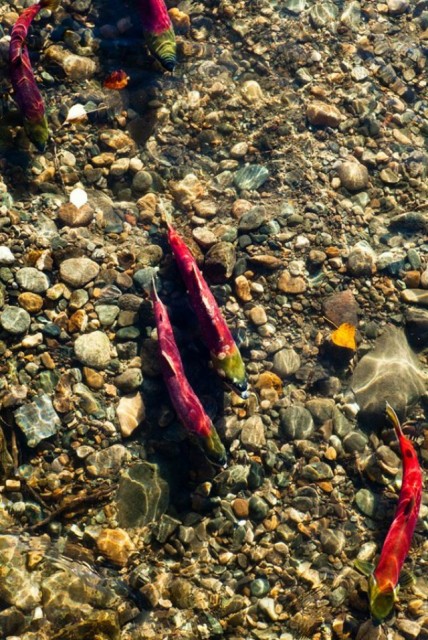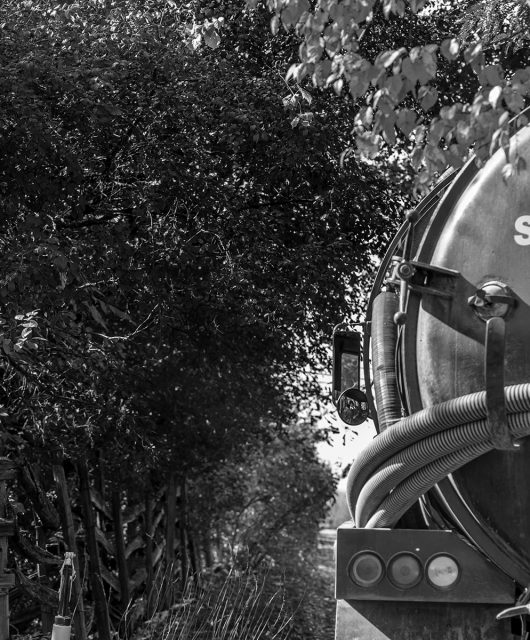[PHOTO CREDIT: Thinkstock]
It won’t be long until millions of sockeye salmon return to the Adams River and what a spectacular sight it will be!
With 2014 being a dominant run millions of sockeye salmon will return to the Adams River from the Pacific Ocean; a trek that lasts about 17 days and covers 485 kilometres. The Adams River is the same river these fish started life in and it is where they will return to spawn and then die.
They start their journey from the Pacific Ocean where they have spent their adult life, migrate up the Fraser and Thompson Rivers, swimming their way upstream past swift currents and rapids, not even eating once they reach fresh water. Along this amazing journey, their bodies transform from blue-gray into a brilliant red colour.
They’ll reach Adams River in early October, one of the most important sockeye salmon breeding areas in North America. Here the female finds a place to lay her eggs and builds a “redd” or a depression in the gravel bed with her tail. She lays her eggs which are then fertilized by the male that has been protecting her from other males.
This is repeated upstream several times until all her eggs are laid – all three to four thousand of them! In only a matter of days these adults will die, completing their life cycle.
By April little fry emerge from the gravel. These fry travel to Shuswap Lake where they stay for about a year. By then they’ll be fingerlings and will make the journey to the Thompson River, then the Fraser, ultimately making their way to the Pacific Ocean where they’ll stay until their fourth year. Then it will be their turn to make the trek back to their place of birth – The Adams River.
If you can make it to Adams River for the 2014 Salute to the Sockeye (October 3 – October 26) be sure to look for CWF’s interactive exhibit the first week of the festival.
If you can’t be there in person, be sure to watch our blog for updates and visit our website for more information about salmon.
To read more fascinating nature news, subscribe to Canadian Wildlife magazine, official media sponsor of the 2014 Salute to the Sockeye festival.
Donate now to support CWF’s important work.
———————————————————————————————————————————————————————-
Bientôt, des millions de saumons rouges reviendront dans la rivière Adams, et ce sera un spectacle extraordinaire!
L’année 2014 correspondant à une montaison dominante, des millions de saumons rouges seront de retour dans la rivière Adams, en provenance de l’océan Pacifique; une migration d’environ 17 jours, couvrant 485 km! La rivière Adams est celle où ces poissons ont commencé leur vie, et c’est ici qu’ils reviendront frayer puis mourir.
Ils commencent leur voyage dans l’océan Pacifique, où ils ont passé leur vie d’adulte, puis remontent le fleuve Fraser et la rivière Thompson, à travers des rapides et de forts courants, sans même manger, jusqu’à ce qu’ils atteignent l’eau douce. Au cours de ce voyage étonnant, leur corps vire du bleu gris au rouge éclatant.
Début octobre, ils atteignent la rivière Adams, l’un des lieux de reproduction des saumons rouges les plus importants en Amérique du Nord. Ici, la femelle construit une « frayère », c’est-à-dire un « nid » ou une dépression dans le lit de graviers avec sa queue. Elle y pond ses œufs, qui sont ensuite fécondés par le mâle qui la protège des autres mâles.
Cette opération est répétée en amont plusieurs fois, jusqu’à ce que tous ses œufs – un total de trois à quatre mille – soient pondus. En quelques jours seulement, ces adultes termineront leur cycle de vie et mourront.
En avril, de petits alevins émergeront du gravier. Ils nageront jusqu’au lac Shuswap, où ils resteront environ un an. Ils seront alors des juvéniles et descendront la rivière Thompson, puis le fleuve Fraser, pour terminer dans l’océan Pacifique où ils resteront jusqu’à leur quatrième année. Ensuite, ce sera leur tour d’entreprendre la migration de retour vers leur lieu de naissance – la rivière Adams.
Si vous pouvez vous rendre à la rivière Adams pour le festival « Hommage aux saumons rouges » (du 3 au octobre), n’oubliez pas de passer voir l’exposition interactive de la FCF qui sera présente sur les lieux pendant la première semaine du festival.
Si vous ne pouvez pas être là en personne, n’oubliez pas de consulter les mises à jour de notre blogue, de même que notre site Web pour plus d’informations sur les saumons. Pour découvrir davantage de nouvelles fascinantes au sujet de la nature, abonnez-vous au magazine Canadian Wildlife/Biosphère, commanditaire médiatique officiel du festival « Hommage aux saumons rouges » 2014.
Faites un don dès maintenant pour soutenir l’important travail de la FCF.




1 comment
Perhaps an idea: for people who don’t know exactly where the Adams river and the park there are, to post a direction map if possible.